What's the difference between hand-brewed coffee and siphon pot coffee? The siphon pot can make coffee with high alcohol thickness.
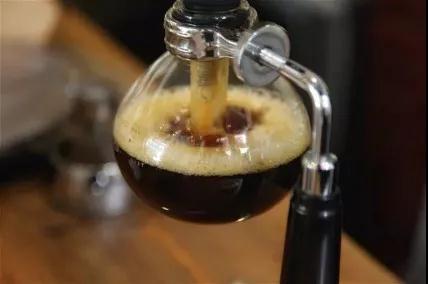
Professional coffee knowledge exchange more coffee bean information please follow the coffee workshop (Wechat official account cafe_style)
What's the difference between hand-brewed coffee and siphon pot coffee? Can the siphon pot make coffee with high alcohol thickness?
Coffee novices who like to use siphon pots must be looking forward to the cleaning tips of siphon pots. Then keep reading.
Siphon brewed coffee is a favorite of many coffee fans. Some people say that because it can extract the most perfect part of coffee, especially if the characteristics of coffee beans have that kind of refreshing and clear acid, and the acid has a mellow flavor, siphon cooking can give full play to the characteristics of this kind of coffee.
There are also many people who like the precision of siphon cooking with a little laboratory flavor, watching the water rise when boiling, the coffee extracted into black drops, step by step in the hands of coffee brewers, compared to Italian machine coffee often to give part of the process to a machine, siphon coffee seems to be more able to satisfy some people who like to do DIY.
[champion coffee conditioner-siphon coffee demonstration]
Authors: Iwashi Kangxiao, Ji Lianggang
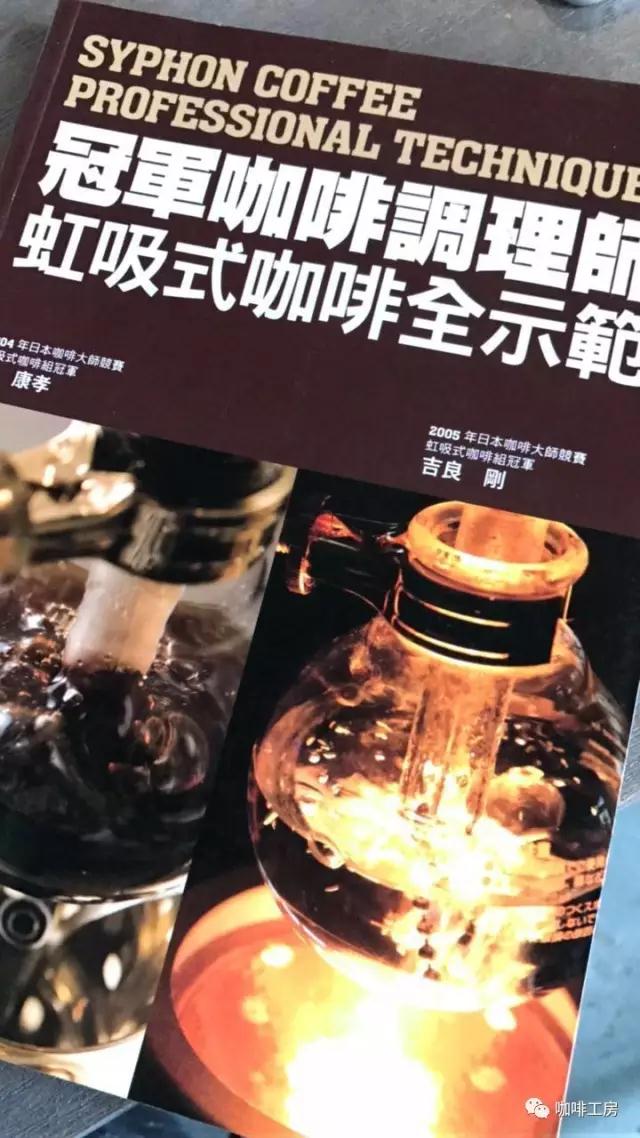
In order to enable more coffee lovers to taste the most authentic and mellow coffee, this book specially invites two masters who won the title of "siphon Coffee Group Champion" in the Japanese Coffee Masters Competition, aiming at their long-term research on siphon coffee brewing skills, applicable taste changes, and siphon coffee processing tips accumulated from the process of opening a shop. Make a very incisive explanation with exquisite pictures and text, so that coffee fans can enter the hall of siphon coffee and experience its irreplaceable charm!

The two champions personally demonstrated:
In order to inherit the superb brewing skills of "siphon Coffee", the master spared no effort to present the best results and tricks after repeated experiments in this book without reservation, so that readers can grasp the tips immediately. Lucky to get the rich experience of the masters for many years!
Explain the graphical steps clearly:
In the process of siphon coffee brewing, there are many small moves that will affect the quality, which is often the decisive point of a cup of coffee. This book starts with beautiful pictures, starting with the principle of siphon, explaining each step step by step and reminding each detail to pay attention to.

As long as you follow the method in the book, you can also make professional-grade coffee! It is a book worthy of reference for siphon lovers!
Full demonstration of siphon coffee-application, extraction of coffee for 2 people
Step 1:
Pour 2 servings of coffee powder (25g) into the upper pot. When pouring into the upper pot, the coffee powder is easily attached to the inner wall of the upper pot, so you must be very careful. Mr. Kira, the siphon barista, pours the coffee powder into the pot with a stainless steel cup with a diameter of 6 centimeters. Because it is made of stainless steel, the coffee powder will not be electrostatically attached to the pot wall.
Pour the hot water into the pot of 160ML, ready to begin to extract coffee. The hot water in the next pot is boiled and inserted into the upper pot. After the hot water rises, the firepower is reduced a bit and stirred for the first time.

The first stirring: take the stirring rod as the axis, like holding a pen, holding the stirring stick with the thumb, index finger and middle finger, stirring against the clock, using the flat part of the end of the stirring bar to mix the coffee powder floating on the water into the water.
When stirring, you should avoid forming a whirlpool, with the mood of completely dissolving the coffee powder into the water, fix the wrist, take the hand-held part as the fulcrum, draw the ellipse with the mixing stick, and complete the mixing operation quickly.

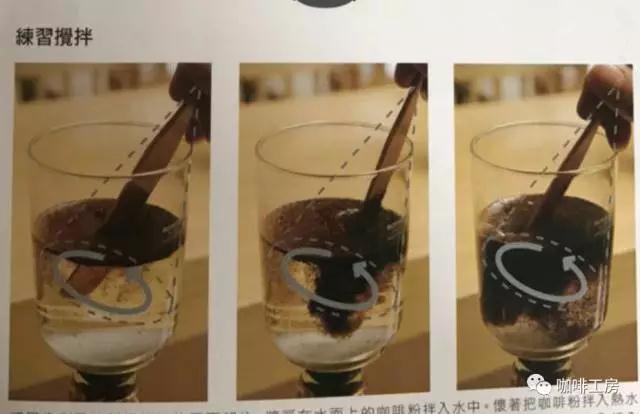
If you stir too much, it is easy to form a double-layer structure of coffee powder and coffee liquid due to the excessive release of gas, and the whitening foam, coffee powder and coffee liquid form a three-layer structure from top to bottom, which means that the first stirring operation was very successful.

Step 2:
Add hot water immediately after the first stirring, replenish approximately boiling 95 degrees hot water. It is recommended to use a kettle that is easy to control the hot water temperature, through the thin spout to avoid damaging foam, coffee powder and liquid layer.
Gently inject hot water (replenish hot water: at least one whole pot (320ml), but enough to extract 2 people (300ml) coffee liquid) to allow the entire layered structure to rise, the impregnation time is 15 seconds, and the replenishment of hot water must be completed within time.

Step 3:
Set soaking time (the extraction time of siphon coffee is basically set to less than 60 seconds, shallow roasted coffee beans are ground during harvest-rough grinding, extraction time is set at 30 seconds-45 seconds, deep roasted coffee beans are picked and fine ground-medium grinding, extraction time is set to 15 seconds-30 seconds)
Turn off the heat at the end of time, stir for the second time after removing the heat source, the mixing direction is the same, the extraction is handled properly, and the coffee powder accumulates into a hill.
Complete the extraction of coffee solution for 2 people.

Siphon pot skills: pressing method, stirring method, pendulum method, cross method
After mastering the basic operation method of siphon pot, in order to further improve the level of siphon use, it is undoubtedly a very important topic to study how to stir. Different stirring will lead to subtle changes in the flavor of coffee. We can try how different stirring will change the coffee from the two aspects of stirring technique and timing.
The grip of the stirring rod
Take the stirring rod as the axis, as if holding a pen, holding the stirring rod with thumb, index finger and 2 fingers.

The middle finger against the stirring rod.

The method of stirring
Although there is a non-mainstream strong mixing method, but the vast majority of stirring have reached a consensus, that is, stirring should be gentle, no matter what means, do not use too much force. But remember that gentle does not mean slow, not like slow motion even if gentle, gentle should be a kind of feeling, is the grasp of strength. Here are some common techniques.
1. Down pressing method
In fact, the pressing method is not stirring, but pressing down the coffee powder originally floating on the water, so that the powder can be in close contact with the water. When pressing down, let one end of the stirring stick slide along the wall of the upper pot, and slowly press the powder into the surface of the water, not to the end, just shallow. The core of the pressing method is quietness, and there must be a state of mind that does not disturb coffee extraction in order to give full play to this technique. This technique is generally used when the water is stirred for the first time as soon as the water rises to the top of the pot.

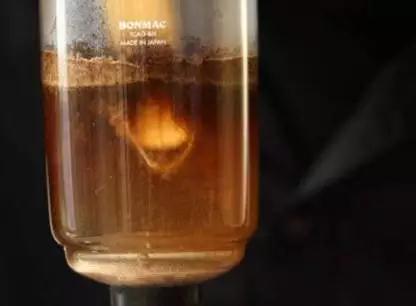
2. Stirring method
The circle method is very easy to master and is usually more like stirring. When stirring, you should also stir gently, insert the mixing piece into the liquid surface at 1/3 of the depth of the kettle, and then stir it in a circle along the kettle wall. This technique is the easiest way to make what the Taiwanese call a hill-shaped powder.

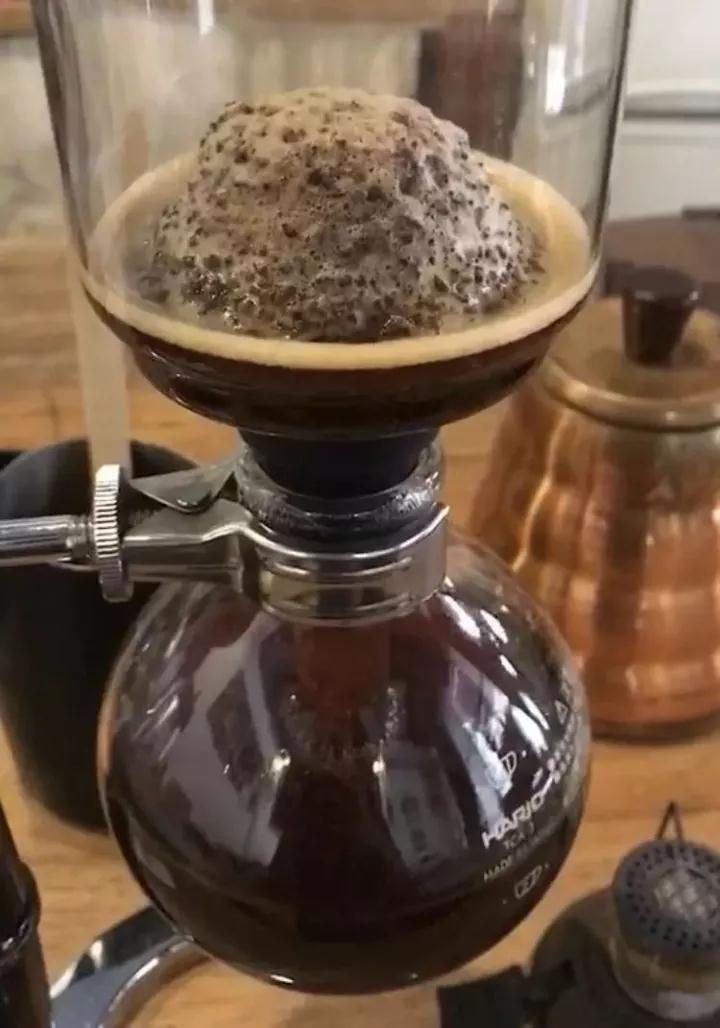
3. Pendulum method
The pendulum method allows your mixing stick to be carried out in the arc of the pendulum, and when stirring should also be gentle, insert the mixing piece into the liquid surface to 1/3 of the depth of the upper pot, then press the coffee powder along the arc shown in figures 1 to 2 below, and pull the mixing stick to the pot wall (try not to touch the pot wall). This technique is the easiest way to make the coffee taste softer.


4. Cross method
The cross method should still be gentle, and the handle will be more demanding, and the stirring trajectory is shown in the picture. Stir the pieces gently back and forth with "cross" on the surface of the water. This technique can be used alone or with the pendulum method.

Now let's take [Yejiaxefi Red Cherry] as an example to make a pot of coffee in these two ways of pollination.

[working principle]
The main principle of coffee extraction in the siphon pot is realized through the pressure difference. First, the lower cup of water is heated to boiling, and then inserted into the upper pot, so that the lower pot is in a state of high pressure. Due to the pressure difference between the lower pot and the upper pot, the hot water is mixed with the upper pot coffee powder and extracted. After the extraction process, the fire source of the lower pot is removed, so that the pressure difference between the lower pot and the upper pot is instantly reduced. The siphon effect between the upper pot and the lower pot will cause the coffee extract to return to the lower cup. If you want to speed up the reflux rate of the coffee extract, you can wipe the lower pot with a dishcloth, which can make the pressure difference between the upper pot and the lower pot smaller and the coffee extract reflux faster.
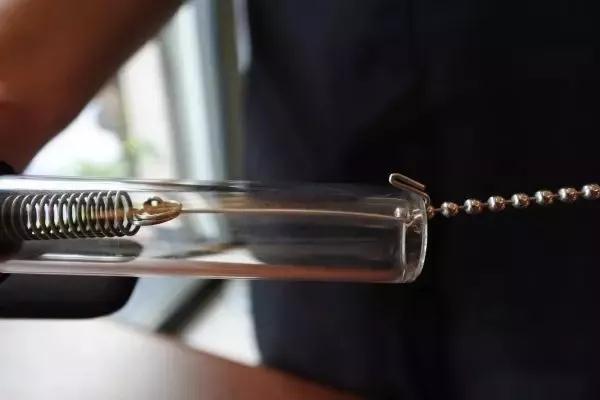
[preparatory work]
1. Add water to the siphon pot, for example, to make coffee for two, then add water to the 5mm above the siphon pot sign for two, because the powder absorbs water, so if you want to make coffee for two, you have to add more water appropriately.
two。 Grind coffee beans, prepare 25 grams of coffee powder (about 15g in a single cup) and moderate grinding (4 scales of small Fuji ghost teeth), that is, the particles are between white sugar and brown sugar.
3. After adding water, remember to dry the outside of the pot with a soft cloth, do not leave water stains, so as to avoid bursting the pot when heating.
4. Fill the next pot with hot water and heat it with a gas stove. Generally, a single cup of coffee uses about 180g of water and 300g for two (powder: 1:12).
5. Now that everything in front of it is done, let's start boiling water.
When the water is heated enough to brew, put the filter in the upper pot and be sure to hook the hook as shown in the picture below. Otherwise, when the water from the pot rushes to the upper pot, the filter will be washed away.
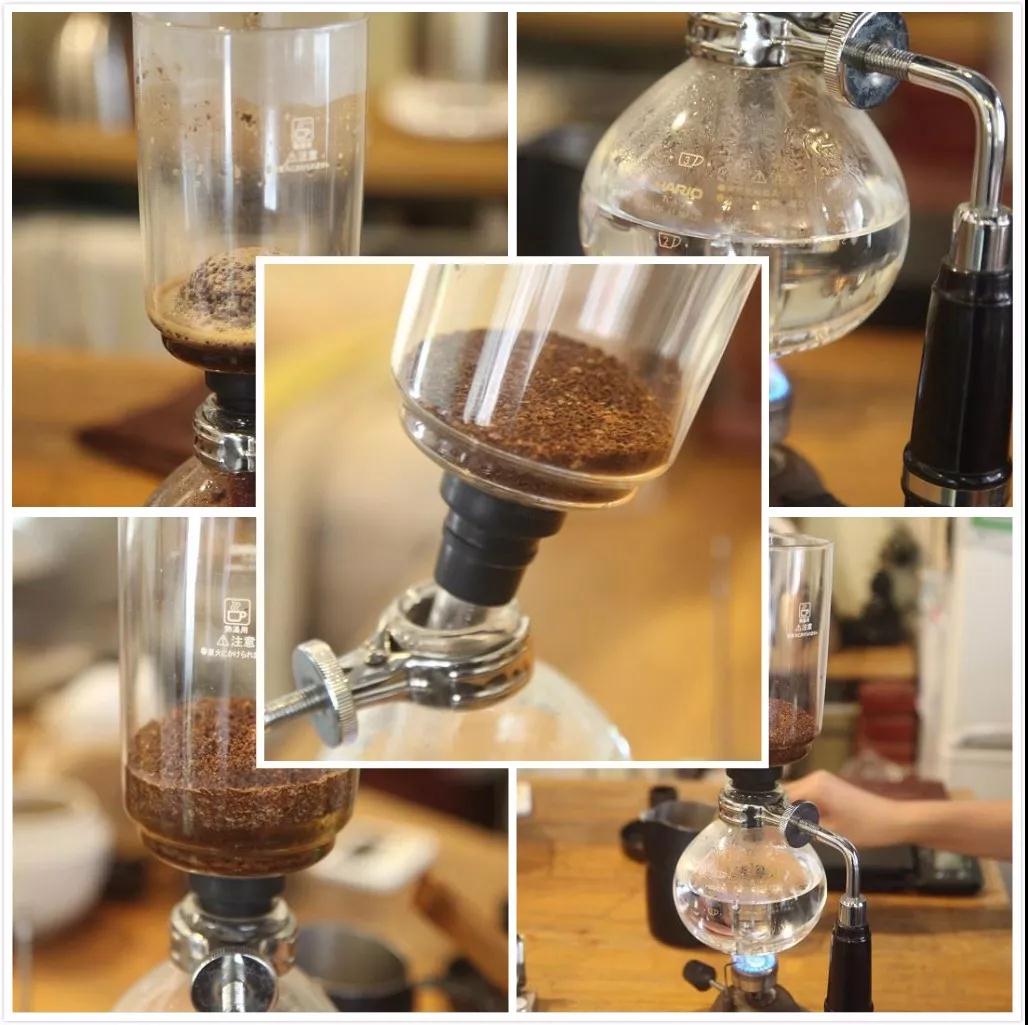
[adding powder first]
To add powder first is to put the coffee powder into the pot, and then put the water on the pot. The requirement of controlling the firepower by adding powder first is relatively high, and the firepower should be adjusted to an appropriate size while the water rises, so as not to produce a large number of bubbles to destroy the steam. at the same time, it is best to boil a pot of water in advance to test whether the position of the filter is in the right place, if it is not in the middle, it will produce a large number of continuous bubbles. The advantage of adding powder first is that there is a gradual warm and wet process for coffee powder, which can reduce the number of circles stirred for the first time, which is more conducive to the formation of steaming effect. However, the temperature control will be poor, so the timing of inserting the upper pot into the next pot will be particularly important, that is to say, it seems simple to add powder first, but in fact, it requires more practical experience than the latter.
Manipulation
(1) when the temperature of the lower pot reaches 90 ℃, pour the powder in and straighten the upper pot.
(2) after the coffee powder is completely soaked in water, the coffee powder is stirred for the first time and the timing starts, and the firepower is adjusted to the appropriate size when the water reaches the pot.
(3) stir for the second time after steaming for 30 seconds.
(4) stir for the last time in about 50 seconds. After stirring, remove the fire and let the coffee liquid flow back.

[after adding powder]
Contrary to adding powder first, adding powder after adding powder is to let the water in the next pot rise completely to the top, and then put in the coffee powder. Before adding powder, we can have plenty of time to reduce the firepower of the fire source just enough to support the water on the pot will not fall back. Then adjust the position of the filter to keep it in the middle, and finally wait a few minutes to let the water temperature drop a little bit. Under normal circumstances, when the water in the next pot rises to the top, the water temperature will be about 95 degrees, so we can lower the water temperature by about 5 degrees and then put in the coffee powder. Generally speaking, the higher the water temperature, the more bitter and even scorched the coffee will be, while the lower the temperature is, the more obvious the sour taste and aroma will be, but too low will also reduce the alcohol content and make the sour taste very exciting. therefore, it is very important to choose a suitable water temperature for coffee powder according to the extracted coffee.
(1) straighten the upper pot when the water temperature is 90 ℃, pour the coffee powder into the pot and time it.
(2) adjust the firepower to a suitable size, steam for 30 seconds and stir for the second time.
(3) stir for the third time in about 50 seconds. After stirring, remove the source of fire and let the coffee liquid return.
[conclusion]

[adding powder first] emphasizes high cleanliness, sufficient and persistent aroma, and obvious flavor of citric acid, citrus and white grape juice. However, the control requirement is relatively high, and poor control can easily lead to insufficient extraction or large over-extraction deviation.
[after adding powder] the taste is relatively rich, and the flavor of caramel and honey in the middle will be more prominent. The cleanliness of the taste is relatively weak, the aroma is not prominent enough to rise, and it is more important for temperature control.
We can try both methods, and even after accumulating some experience, we can choose different methods according to different characteristics of coffee beans or different extraction requirements.

Important Notice :
前街咖啡 FrontStreet Coffee has moved to new addredd:
FrontStreet Coffee Address: 315,Donghua East Road,GuangZhou
Tel:020 38364473
- Prev
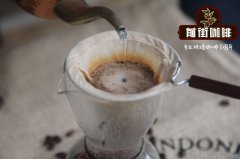
The taste of Blue Mountain Coffee Why is Blue Mountain coffee so expensive? What is Blue Mountain Coffee?
Professional coffee knowledge exchange more coffee bean information please follow the coffee workshop (Wechat official account cafe_style) Blue Mountain Coffee-coffee drinkers have probably heard of Blue Mountain Coffee and know that Jamaica Blue Mountain is a great coffee! But are all the blue mountain coffee we drink real blue mountain coffee? Blue Mountain Coffee is the best coffee in the world. The Blue Mountains are located in Jamaica.
- Next
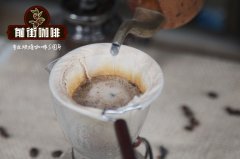
What is Blue Mountain Coffee? Taste and flavor characteristics of Jamaican Blue Mountain Coffee suggestion for brewing Blue Mountain Coffee
Professional coffee knowledge exchange more information about coffee beans Please follow the coffee workshop (Wechat official account cafe_style) Blue Mountain Coffee is the best coffee in the world. The Blue Mountains are located in eastern Jamaica, hence the name because the mountain is surrounded by the Caribbean Sea. Whenever the weather is clear, the sun shines directly on the blue sea, and the mountain peak reflects the bright blue light of the sea.
Related
- Detailed explanation of Jadeite planting Land in Panamanian Jadeite Manor introduction to the grading system of Jadeite competitive bidding, Red bid, Green bid and Rose Summer
- Story of Coffee planting in Brenka region of Costa Rica Stonehenge Manor anaerobic heavy honey treatment of flavor mouth
- What's on the barrel of Blue Mountain Coffee beans?
- Can American coffee also pull flowers? How to use hot American style to pull out a good-looking pattern?
- Can you make a cold extract with coffee beans? What is the right proportion for cold-extracted coffee formula?
- Indonesian PWN Gold Mandrine Coffee Origin Features Flavor How to Chong? Mandolin coffee is American.
- A brief introduction to the flavor characteristics of Brazilian yellow bourbon coffee beans
- What is the effect of different water quality on the flavor of cold-extracted coffee? What kind of water is best for brewing coffee?
- Why do you think of Rose Summer whenever you mention Panamanian coffee?
- Introduction to the characteristics of authentic blue mountain coffee bean producing areas? What is the CIB Coffee Authority in Jamaica?

